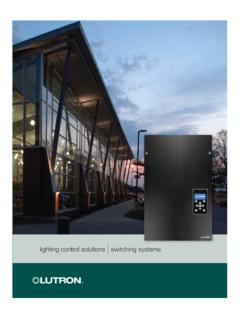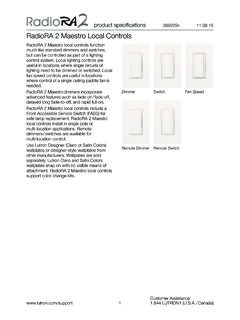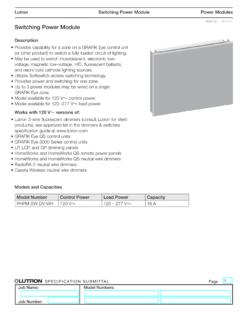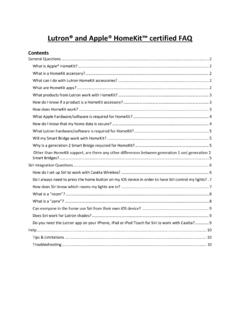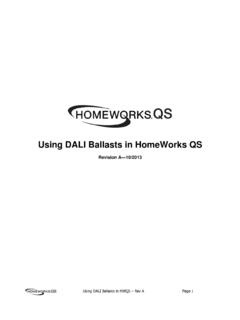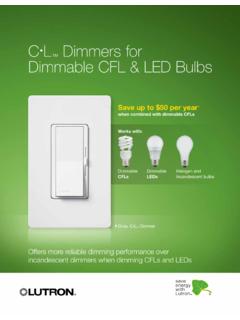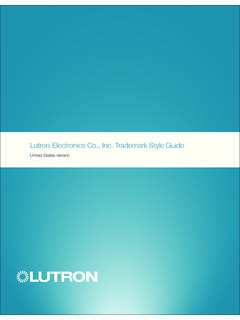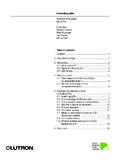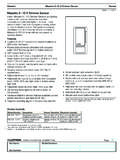Transcription of TLED Lighting Scenarios for Retrofit Applications
1 Technical PaperTLED Lighting Scenarios for Retrofit ApplicationsEthan Biery, LED Engineering LeaderCraig Casey, Senior Building Science EngineerLutron Electronics Co., Inc. January 30, 2017 01/2017 Lutron Electronics Co., Inc. I P/N 367-2689 REV ATechnical PaperTLED Lighting Scenarios for Retrofit Applications2 | Lutron Abstract ..3 Executive summary ..3 Introduction ..4 Types of TLED Retrofits ..5 Scenario 1: UL Type A TLEDs retrofitted with existing fluorescent ballasts ..6 Scenario 2: UL Type B TLEDs wired directly to line voltage.
2 7 Scenario 3: UL Type C TLEDs supplied with dedicated LED drivers ..8 Concerns of TLED Retrofits ..9 Optical Quality ..9 Product Lifetime ..10 Dimming ..10 Conclusion ..11 Technical PaperTLED Lighting Scenarios for Retrofit Applications3 | Lutron Abstract Retrofitting fluorescent fixtures with Tubular (or Troffer) Light-Emitting Diode (TLED) lamps can provide energy-efficient advantages at lower cost than a total Lighting Retrofit , but a full understanding of the various options and tradeoffs is necessary to manage expectations and achieve desired results.
3 I n this whitepaper we will Define the types of TLED retrofits Examine concerns associated with TLED retrofits Recommend best practices for desired results The goal of this whitepaper is to help Lighting professionals specify and install an appropriate TLED solution in Retrofit situations. Executive Summary I n this whitepaper, Lutron offers background information, guidelines, and recommendations for using TLED products as retrofits with fluorescent fixtures and ballasts. We describe the implementation of three different Scenarios , and compare advantages and challenges associated with each scenario 1.
4 UL Type A: TLEDs retrofitted with existing fluorescent ballasts 2. UL Type B: TLEDs wired directly to line voltage 3. UL Type C: TLEDs supplied with dedicated LED drivers For best results in most Applications involving TLED products as retrofits for fluorescent fixtures and ballasts, Lutron recommends the use of Scenario 3, a pre-certified solution consisting of a dedicated LED driver with low-voltage TLED tubes. Technical PaperTLED Lighting Scenarios for Retrofit Applications4 | Lutron I ntroduction This Technical Paper provides information and assistance for users considering Tubular (or Troffer) Light Emitting Diode (TLED) Retrofit options.
5 TLED upgrades of fluorescent fixtures offer advantages such as higher efficacy, longer life, and reduced energy usage compared to traditional fluorescent Lighting . For a successful installation, a full understanding of the various TLED options and their tradeoffs is essential. Special consideration is necessary when using TLEDs with a Lighting control solution and in dimming Applications . In this whitepaper, Lutron offers background information, guidelines, and recommendations for using TLED products. This information is especially critical when the installation currently includes Lutron ballasts and control systems.
6 As of 2016, as determined by an analysis of the LED Lighting Facts database run by the US Department of Energy, TLEDs are one of the fastest-growing categories of LED products1, Growing demand for this category is attributable to the relative ease of installation, energy and maintenance savings, generous utility rebates, and increasingly broad availability of products. There are some tradeoffs with TLEDs; and furthermore, when a dimming control system is already in place, proper product selection is critical to ensure the functionality of the existing system is not compromised.
7 For example, the solution has to ensure that light levels can be fine-tuned (high-end trim, partial on, daylighting), or anticipated energy savings may not be PaperTLED Lighting Scenarios for Retrofit Applications5 | Lutron Types of TLED Retrofits UL describes three categories of TLED Retrofit products under standard 1598C ( Standard for Light-Emitting Diode (LED) Retrofit Luminaire Conversion Kits ), and each scenario may be considered for dimming or non-dimming Applications 1. UL Type A: TLEDs retrofitted with existing fluorescent ballasts 2.
8 UL Type B: TLEDs wired directly to line voltage 3. UL Type C: TLEDs supplied with dedicated LED drivers Note there are also related Retrofit kits that are used to upgrade an existing fixture to LED technology, but do not use the existing T8 lamp form factor or sockets. Such products are outside the direct scope of this document, but may present the same concerns in many PaperTLED Lighting Scenarios for Retrofit Applications6 | Lutron Scenario 1: TLEDs retrofitted with existing fluorescent ballasts (UL Type A) In this scenario, the fluorescent lamps are removed and replaced with specialized LED lamps that work with the existing ballast.
9 This type of LED lamp has sophisticated internal electronics that simulate the electrical characteristics of a fluorescent lamp, essentially tricking the ballast into thinking a fluorescent lamp is still connected. When the fluorescent ballast remains in place, installing TLEDs into existing fixtures requires minimum labor and no modification to existing wiring or sockets, but the additional circuitry typically adds cost to the LED lamp and decreases its efficiency compared to an LED lamp used with an LED driver. Because all ballasts are not created equal, compatibility issues may arise, and this seemingly simple scenario can quickly become complicated and time-consuming.
10 Not all fluorescent ballasts are compatible with all LED lamps; therefore, TLED lamp manufacturers often provide compatibility lists showing combinations that have been previously tested to indicate good performance. LED compatibility issues are particularly problematic with fluorescent dimming ballasts because the precise electrical characteristics of the LED lamp are more critical for proper dimming performance. Specifically, a TLED lamp on a fluorescent dimming ballast may dim, but not low, smooth, or linearly enough to satisfy customer expectations derived from their fluorescent dimming experience.
